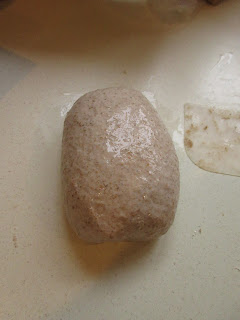I have now made this recipe more than half a dozen times...it is a pure sourdough loaf, but it has no intermediate bulk rising, and gives a very nice even crumb. If you want to see what I have posted previously: do go to Finnish Rye and Finnish Rye Again. During cooler months, I have allowed the dough to rise in the tin at ambient kitchen temps, but as it is now rather warm...ambient day temperature 24 C, I prefer to do the rise during the day when I can keep my eye on the loaf.
For my personal taste I now half the amount of malt syrup, and have used honey this time.
This is the rye sourdough just removed from the fridge at about 9 pm.
I start by weighing into my bowl 25g whole rye flour
Then I weighed in 35g wholewheat spelt
followed by 30g water at room temperature
and finally 35g of the rye sourdough starter from the fridge
when it was mixed up this is what it looked like, before being covered with its shower cap, and left overnight on the kitchen worktop. It looks just the same as Angela's mixture.
On top goes 75g of rye flour
Then 6g salt
And finally 100g milk, 50g water, and 30g honey
Then I mix it all up by hand in the bowl
It is a fairly sticky dough, most rye flours result in a sticky dough...but no more flour please. I use my trusty scraper to bring bits off the work surface and into the dough ball at regular intervals during kneading. This is what it looks like after ten minutes....
I know my 1 lb tins work very well with 500g standard dough or a little more sourdough up to about 550g. Just to compare with other tins...this tin holds 750g water. I usually weigh the water held by different tins so that I can scale off the right amount for different tins. By scaling up the amounts in recipes I am able bake more than one loaf using different sized tins. For example for a tin which holds 1000g water I use 1000 / 750 x 550 = 730g of dough.
Because my tins are a little old..I find I need to grease them very well for these long rise loaves..I use butter and a little layer of rye flakes, and the loaves comes out nicely. I would recommend preparing them before you start to knead, as it is handy to have them ready to pop the dough in, and not have to keep washing one's hands.
Using wet hands, which Jane Mason recommends, makes shaping the dough a breeze..and it is ready to roll in some flakes. This is not in the recipe but I find it really helps with my tins.
The dough is now in the tin...and will sit rising under its shower cap.
Its just ten minutes to go before the first of the three hours are up...the dough has a long way to go, so I set the timer for another hour, and also another two hours. I've had this timer for over ten years...and it is an absolute must for me, as I am usually doing several things at any time. I was sorry to read that Salter have changed their design. If I needed to get another one I have found one which looks almost exactly the same!
It took six hours rising to get the level of rise I was expecting
The oven was preheated to 230 C, with a baking tray to put the tin onto. I find this bakes the bottom of the loaf nicely. After 10 minutes I reduced the temp to 190 C as it is a fan oven. After 20 minutes, rather than the 30 minutes given in the recipe, the loaf looked cooked. Usually I find the timings about right, but there may be up to four loaves in the oven...this time there was just the one. To check if the loaf was baked fully, I used the thermapen: 95 C...and yes, the loaf felt right. From the amount of oven spring, I think another half an hour rise would have been OK.
Going through the notes made during previous bakes of this recipe, and comparing it with this run through, I realise that with sourdough there can be so many factors leading to variations...usually time variations. So judgement based on experience is the best guidance, and allowing plenty of time is of the essence!




















No comments:
Post a Comment